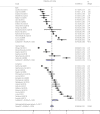Prevalence of diabetes and its effects on stroke outcomes: A meta-analysis and literature review
- PMID: 30220102
- PMCID: PMC6497593
- DOI: 10.1111/jdi.12932
Prevalence of diabetes and its effects on stroke outcomes: A meta-analysis and literature review
Abstract
Aims/introduction: Diabetes mellitus is an established risk factor for stroke and maybe associated with poorer outcomes after stroke. The aims of the present literature review were to determine: (i) the prevalence of diabetes in acute stroke patients through a meta-analysis; (ii) the association between diabetes and outcomes after ischemic and hemorrhagic stroke; and (iii) to review the value of glycated hemoglobin and admission glucose-based tests in predicting stroke outcomes.
Materials and methods: Ovid MEDLINE and EMBASE searches were carried out to find studies relating to diabetes and inpatient stroke populations published between January 2004 and April 2017. A meta-analysis of the prevalence of diabetes from included studies was undertaken. A narrative review on the associations of diabetes and different diagnostic methods on stroke outcomes was carried out.
Results: A total of 66 eligible articles met inclusion criteria. A meta-analysis of 39 studies (n = 359,783) estimated the prevalence of diabetes to be 28% (95% confidence interval 26-31). The rate was higher in ischemic (33%, 95% confidence interval 28-38) compared with hemorrhagic stroke (26%, 95% confidence interval 19-33) inpatients. Most, but not all, studies found that acute hyperglycemia and diabetes were associated with poorer outcomes after ischemic or hemorrhagic strokes: including higher mortality, poorer neurological and functional outcomes, longer hospital stay, higher readmission rates, and stroke recurrence. Diagnostic methods for establishing diagnosis were heterogeneous between the reviewed studies.
Conclusions: Approximately one-third of all stroke patients have diabetes. Uniform methods to screen for diabetes after stroke are required to identify individuals with diabetes to design interventions aimed at reducing poor outcomes in this high-risk population.
Keywords: Diabetes; Outcomes; Stroke.
© 2018 The Authors. Journal of Diabetes Investigation published by Asian Association for the Study of Diabetes (AASD) and John Wiley & Sons Australia, Ltd.
Figures



References
-
- International Diabetes Federation . IDF Diabetes Atlas, 7th edn Brussels: International Diabetes Federation, 2015.
-
- Cavender MA, Scirica BM, Raz I, et al Cardiovascular outcomes of patients in SAVOR‐TIMI 53 by baseline hemoglobin A1c. Am J Med 2016; 129: 340.e341–348.e341. - PubMed
-
- O'Donnell MJ, Chin SL, Rangarajan S, et al Global and regional effects of potentially modifiable risk factors associated with acute stroke in 32 countries (INTERSTROKE): a case‐control study. Lancet 2016; 388: 761–775. - PubMed
-
- Hu G, Jousilahti P, Sarti C, et al The effect of diabetes and stroke at baseline and during follow‐up on stroke mortality. Diabetologia 2006; 49: 2309–2316. - PubMed
-
- Gray CS, Scott JF, French JM, et al Prevalence and prediction of unrecognised diabetes mellitus and impaired glucose tolerance following acute stroke. Age Ageing 2004; 33: 71–77. - PubMed
Publication types
MeSH terms
LinkOut - more resources
Full Text Sources
Other Literature Sources
Medical
Miscellaneous

